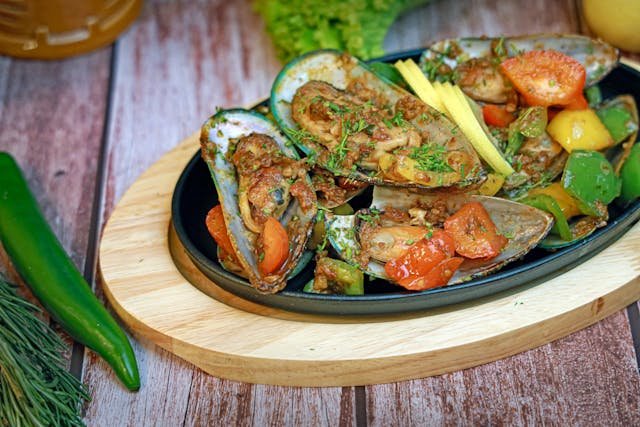

Using Norwegian in a Restaurant: From Ordering to Paying
Table of Contents
ToggleIntroduction
Norway, with its stunning fjords, vibrant cities, and rich cultural heritage, is a country that captivates visitors from around the world. One of the best ways to immerse yourself in Norwegian culture is through its cuisine. However, navigating a restaurant experience in a foreign language can be daunting. This comprehensive guide will walk you through the process of using Norwegian in a restaurant, from the moment you step in until you pay the bill and leave.
Whether you’re a tourist planning a trip to Norway or an expat looking to improve your language skills, this article will equip you with the necessary vocabulary, phrases, and cultural insights to confidently dine out in Norwegian. By the end of this guide, you’ll be ready to order your meal, engage in small talk with the staff, and even handle any unexpected situations that may arise during your dining experience.
If you’re looking to enhance your Norwegian language skills beyond restaurant situations, consider enrolling in group Norwegian classes at the NLS Norwegian Language School in Oslo. You can find more information and register at https://nlsnorwegian.no/group-norwegian-classes/.
1. Arriving at the Restaurant
1.1 Making a Reservation
Before you even step foot in the restaurant, you might want to make a reservation, especially if it’s a popular establishment or you’re dining during peak hours. Here’s how you can make a reservation in Norwegian:
- “Jeg vil gjerne reservere et bord.” (I would like to reserve a table.)
- “Kan jeg bestille et bord for [antall] personer på [dag] klokken [tid]?” (Can I book a table for [number] people on [day] at [time]?)
- “Er det mulig å få et bord ved vinduet?” (Is it possible to get a table by the window?)
Remember to be polite and use “takk” (thank you) liberally throughout your conversation.
1.2 Entering the Restaurant
As you enter the restaurant, you’ll likely be greeted by a host or hostess. Here are some common greetings and phrases you might hear or use:
- “Hei” or “God dag” (Hello or Good day)
- “Velkommen” (Welcome)
- “Har dere en reservasjon?” (Do you have a reservation?)
- “Ja, vi har en reservasjon på [navn]” (Yes, we have a reservation under [name])
- “Nei, vi har ikke reservert. Har dere et ledig bord?” (No, we haven’t made a reservation. Do you have an available table?) a Restaurant: From Ordering to Paying Note: The provided information was insufficient to generate a response.
1.3 Being Seated
Once you’ve been acknowledged, the host will likely lead you to your table. Here are some phrases you might hear:
- “Vær så god, følg meg.” (Please, follow me.)
- “Her er bordet deres.” (Here is your table.)
- “Er dette bordet greit?” (Is this table okay?)
You can respond with:
- “Ja, takk. Dette er fint.” (Yes, thank you. This is nice.)
- “Kan vi få et annet bord?” (Can we have a different table?)
2. Reviewing the Menu
2.1 Asking for the Menu
Once seated, you’ll need to ask for the menu if it’s not already on the table. Here’s how:
- “Kan vi få se menyen, takk?” (Can we see the menu, please?)
- “Har dere en engelsk meny?” (Do you have an English menu?)
2.2 Understanding Menu Sections
Norwegian menus typically follow a structure similar to other Western countries. Here are some common menu sections you might encounter:
- Forretter (Starters/Appetizers)
- Hovedretter (Main Courses)
- Desserter (Desserts)
- Drikke (Drinks)
- Dagens rett (Dish of the day)
- Barnemeny (Children’s menu)
2.3 Common Dish Types and Ingredients
To help you navigate the menu, here are some common Norwegian dishes and ingredients you might encounter:
- Fisk og skalldyr (Fish and shellfish)
- Kjøtt (Meat)
- Vegetarretter (Vegetarian dishes)
- Suppe (Soup)
- Salat (Salad)
- Brød (Bread)
- Ost (Cheese)
- Poteter (Potatoes)
- Grønnsaker (Vegetables)
2.4 Asking About Dishes
If you’re unsure about a dish or have dietary restrictions, don’t hesitate to ask the server. Here are some useful phrases:
- “Hva inneholder denne retten?” (What does this dish contain?)
- “Er det nøtter i denne retten?” (Are there nuts in this dish?)
- “Jeg er allergisk mot [allergen]. Er det trygt for meg å spise dette?” (I’m allergic to [allergen]. Is it safe for me to eat this?)
- “Kan du anbefale en rett?” (Can you recommend a dish?)
3. Ordering Your Meal
3.1 Calling the Waiter
When you’re ready to order, you’ll need to get the waiter’s attention. In Norway, it’s common to make eye contact and give a small nod or raise your hand slightly. You can also use these phrases:
- “Unnskyld” (Excuse me)
- “Kan vi bestille?” (Can we order?)
3.2 Placing Your Order
Now comes the exciting part – ordering your meal! Here are some phrases to help you through this process:
- “Jeg vil gjerne ha…” (I would like to have…)
- “Kan jeg få…” (Can I get…)
- “Til forrett vil jeg ha…” (For starter, I’ll have…)
- “Som hovedrett tar jeg…” (For main course, I’ll take…)
- “Og til dessert…” (And for dessert…)
Remember to be polite and use “takk” after your order.
3.3 Specifying Cooking Preferences
If you’re ordering meat or fish, you might want to specify how you’d like it cooked:
- “Kan jeg få biffen medium stekt?” (Can I have the steak cooked medium?)
- “Jeg vil gjerne ha fisken godt stekt.” (I’d like the fish well done.)
3.4 Ordering Drinks
Don’t forget to order something to drink with your meal:
- “Kan jeg få en [drikke], takk?” (Can I have a [drink], please?)
- “Hva slags vin anbefaler du til denne retten?” (What kind of wine do you recommend with this dish?)
- “Kan vi få en flaske husets rødvin?” (Can we get a bottle of the house red wine?)
- “Kan jeg få et glass vann?” (Can I have a glass of water?)
3.5 Special Requests
If you have any special requests or dietary requirements, don’t hesitate to mention them:
- “Kan jeg få dressingen på siden?” (Can I have the dressing on the side?)
- “Er det mulig å bytte ut poteter med salat?” (Is it possible to substitute the potatoes with salad?)
- “Kan jeg få retten uten [ingrediens]?” (Can I have the dish without [ingredient]?)
4. During the Meal
4.1 Expressing Satisfaction
As you enjoy your meal, you might want to express your satisfaction to the waiter or your dining companions:
- “Dette smaker veldig godt!” (This tastes very good!)
- “Maten er utmerket.” (The food is excellent.)
- “Komplimenter til kokken!” (Compliments to the chef!)
4.2 Asking for Additional Items
If you need anything during your meal, here are some useful phrases:
- “Kan jeg få litt mer brød?” (Can I have some more bread?)
- “Kan vi få en ekstra serviett?” (Can we have an extra napkin?)
- “Unnskyld, men jeg mangler en gaffel.” (Excuse me, but I’m missing a fork.)
4.3 Dealing with Issues
If there’s a problem with your meal, it’s important to communicate this politely:
- “Unnskyld, men dette er ikke det jeg bestilte.” (Excuse me, but this is not what I ordered.)
- “Denne biffen er for rå. Kan du steke den litt mer?” (This steak is too rare. Can you cook it a bit more?)
- “Dette smaker litt salt. Er det mulig å få en annen rett?” (This tastes a bit salty. Is it possible to get a different dish?)
5. After the Meal
5.1 Ordering Dessert or Coffee
After your main course, you might want to order dessert or coffee:
- “Kan vi se på dessertmenyen?” (Can we see the dessert menu?)
- “Jeg vil gjerne ha en kaffe etter maten.” (I’d like to have a coffee after the meal.)
- “Har dere noen spesielle desserter å anbefale?” (Do you have any special desserts to recommend?)
5.2 Asking for the Bill
When you’re ready to leave, you’ll need to ask for the bill:
- “Kan vi få regningen, takk?” (Can we have the bill, please?)
- “Er det mulig å betale nå?” (Is it possible to pay now?)
5.3 Splitting the Bill
If you’re dining with others and want to split the bill, you can say:
- “Kan vi dele regningen?” (Can we split the bill?)
- “Kan vi betale hver for oss?” (Can we pay separately?)
5.4 Tipping
Tipping isn’t as common in Norway as in some other countries, as service charges are usually included in the bill. However, if you received exceptional service, you might want to leave a small tip. You can simply round up the bill or add a small amount (5-10% is considered generous). If you want to leave a tip, you can say:
- “Behold vekslepengene.” (Keep the change.)
- “Legg til 10% i tips, takk.” (Add 10% for tip, please.)
6. Paying and Leaving
6.1 Methods of Payment
In Norway, most restaurants accept both cash and cards. Here are some phrases you might need:
- “Tar dere kort?” (Do you accept cards?)
- “Kan jeg betale med kontanter?” (Can I pay with cash?)
- “Har dere Vipps?” (Do you have Vipps? – a popular Norwegian mobile payment app)
6.2 Expressing Gratitude
As you prepare to leave, don’t forget to thank the staff:
- “Tusen takk for maten.” (Thank you very much for the food.)
- “Måltidet var utmerket.” (The meal was excellent.)
- “Ha en fin kveld!” (Have a nice evening!)
6.3 Reserving for Next Time
If you enjoyed your experience, you might want to make a reservation for your next visit:
- “Kan vi reservere et bord for neste [dag]?” (Can we reserve a table for next [day]?)
- “Når er deres roligste tid?” (When is your quietest time?)
7. Cultural Tips and Etiquette
7.1 Dining Customs
Understanding Norwegian dining customs can enhance your restaurant experience:
- Norwegians typically eat dinner earlier than in some other countries, often around 5-7 PM.
- It’s common to say “Takk for maten” (Thanks for the food) to your host or dining companions after a meal.
- In more casual settings, it’s not unusual to clear your own table by bringing your dishes to a designated area.
7.2 Alcohol Etiquette
If you’re planning to drink alcohol with your meal, keep these points in mind:
- The legal drinking age for beer and wine is 18, while for spirits it’s 20.
- It’s customary to wait until everyone at the table has received their drink before taking the first sip.
- A common toast in Norwegian is “Skål!” (Cheers!)
7.3 Dress Code
Most Norwegian restaurants don’t have strict dress codes, but it’s always good to be prepared:
- For casual dining, smart casual attire is usually acceptable.
- For high-end restaurants, it’s best to dress more formally.
- When in doubt, you can always ask when making a reservation: “Er det noen spesiell kleskode?” (Is there any specific dress code?)
8. Useful Vocabulary
To help you navigate your Norwegian dining experience with confidence, here’s a list of useful vocabulary:
- Meny (Menu)
- Servitør/Servitrise (Waiter/Waitress)
- Bestille (To order)
- Anbefale (To recommend)
- Allergisk (Allergic)
- Glutenfri (Gluten-free)
- Vegetariansk (Vegetarian)
- Vegansk (Vegan)
- Laktosefri (Lactose-free)
- Tallerken (Plate)
- Bestikk (Cutlery)
- Gaffel (Fork)
- Kniv (Knife)
- Skje (Spoon)
- Glass (Glass)
- Serviett (Napkin)
- Salt (Salt)
- Pepper (Pepper)
- Regning (Bill)
- Betale (To pay)
- Kredittkort (Credit card)
- Kontanter (Cash)
Conclusion
Navigating a restaurant experience in Norwegian may seem daunting at first, but with practice and confidence, you’ll find it to be an enjoyable and rewarding part of your time in Norway. Remember, most Norwegians appreciate the effort foreigners make to speak their language, so don’t be afraid to try out your Norwegian skills, even if they’re not perfect.
By familiarizing yourself with the phrases and customs outlined in this guide, you’ll be well-prepared to handle any dining situation, from making a reservation to paying the bill. Not only will this enhance your culinary experiences, but it will also deepen your appreciation for Norwegian culture and hospitality.
If you’re inspired to take your Norwegian language skills to the next level, consider enrolling in group Norwegian classes at the NLS Norwegian Language School in Oslo. You can find more information and register at https://nlsnorwegian.no/group-norwegian-classes/. These classes can help you build on the restaurant-specific language covered in this guide and expand your ability to communicate in a wide range of everyday situations.
Whether you’re a short-term visitor or planning a longer stay in Norway, mastering the art of dining out in Norwegian will undoubtedly enrich your experience and create lasting memories of your time in this beautiful Scandinavian country. God appetitt! (Bon appétit!)

Norwegian A1-A2
Course Overview The Norwegian A1-A2 course is an online program focused on teaching essential Norwegian grammar and vocabulary. It includes a variety of materials and topics, with opportunities to interact with a Norwegian teacher entirely online. Curriculum Highlights The course covers key areas such as grammar and vocabulary and topics such as family, daily life, education, work, traditions, and leisure activities. Who Should Enroll? This course is perfect for beginners or those at the A1 or A2 levels who want to improve their Norwegian skills. What You Get Access to the full Norwegian A1-A2 course. A monthly 1-hour online conversation with a teacher. Many written and oral assignments. Comprehensive information on Norwegian grammar, Norwegian vocabulary and how to use them, important sentence structures, etc. Tips on additional resources to further enhance your Norwegian learning.
0 students enrolled
Last updated Dec 10th, 2024
If you want to learn Norwegian, you can register for classes here. We look forward to hearing from you and helping you become fluent in Norwegian.






